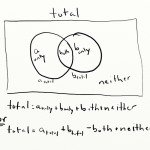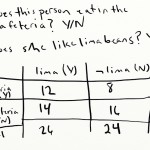It’s no surprise that there are a lot of overlapping sets or Venn Diagram questions on the GMAT.
For many people it’s incredibly difficult to figure out whether to use a diagram, a table, or perhaps simple algebra.
The answer to this might be best chalked up to “feel,” but there are actually good reasons to use each of them.
Two Part Venn Diagram:
If it’s a standard overlapping sets question with Set A, Set B, and the overlap BandC, there’s no reason not to draw the picture.
(image)
It’s probably easier to organize this graphically than it would be to set up an equation, despite the admonitions of the Official Guide.
Tables:
If it’s a question that involves four or more variables with binary opposition (that is, YES/NO, ON/OFF, etc.): e.g., as in A, notA, B, and not B, then I would suggest a table.

Three Part Venn Diagram:
Many books only focus on the strict way to create these: in a lot of cases–especially in the Official Guide–this is an algebraic method as in Question 178 in the OG2015 or Question XXX in OG2016.
That would be this method:
However, there is a new species of Three-Part Venn Diagram question that “requires” a graphical explanation. While an algebraic explanation is possible, it’s thoroughly pointless and will take a good 5-7 minutes to solve!
This is a video on how to tackle one of these clever little monsters:
Enjoy!
Click HERE to arrange a
FREE PHONE CONSULTATION